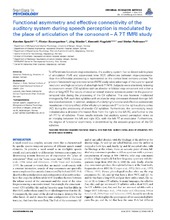| dc.contributor.author | Specht, Karsten | |
| dc.contributor.author | Baumgartner, Florian | |
| dc.contributor.author | Stadler, Jörg | |
| dc.contributor.author | Hugdahl, Kenneth | |
| dc.contributor.author | Pollmann, Stefan | |
| dc.date.accessioned | 2014-12-09T09:17:34Z | en_US |
| dc.date.accessioned | 2014-12-09T20:36:12Z | en_US |
| dc.date.accessioned | 2014-12-11T09:15:41Z | |
| dc.date.available | 2014-12-11T09:15:41Z | |
| dc.date.issued | 2014-06-11 | eng |
| dc.identifier.issn | 1664-1078 | |
| dc.identifier.uri | https://hdl.handle.net/1956/8901 | |
| dc.description.abstract | To differentiate between stop-consonants, the auditory system has to detect subtle place of articulation (PoA) and voice-onset time (VOT) differences between stop-consonants. How this differential processing is represented on the cortical level remains unclear. The present functional magnetic resonance (fMRI) study takes advantage of the superior spatial resolution and high sensitivity of ultra-high-field 7 T MRI. Subjects were attentively listening to consonant–vowel (CV) syllables with an alveolar or bilabial stop-consonant and either a short or long VOT. The results showed an overall bilateral activation pattern in the posterior temporal lobe during the processing of the CV syllables. This was however modulated strongest by PoA such that syllables with an alveolar stop-consonant showed stronger left lateralized activation. In addition, analysis of underlying functional and effective connectivity revealed an inhibitory effect of the left planum temporale (PT) onto the right auditory cortex (AC) during the processing of alveolar CV syllables. Furthermore, the connectivity result indicated also a directed information flow from the right to the left AC, and further to the left PT for all syllables. These results indicate that auditory speech perception relies on an interplay between the left and right ACs, with the left PT as modulator. Furthermore, the degree of functional asymmetry is determined by the acoustic properties of the CV syllables. | en_US |
| dc.language.iso | eng | eng |
| dc.publisher | Frontiers | eng |
| dc.rights | Attribution CC BY | eng |
| dc.rights.uri | http://creativecommons.org/licenses/by/3.0/ | eng |
| dc.subject | functional magnetic resonance imaging | eng |
| dc.subject | ultra high field | eng |
| dc.subject | auditory cortex | eng |
| dc.subject | place of articulation | eng |
| dc.subject | VOT | eng |
| dc.subject | dynamic causal modeling | eng |
| dc.title | Functional asymmetry and effective connectivity of the auditory system during speech perception is modulated by the place of articulation of the consonant – A 7 T fMRI study | eng |
| dc.type | Peer reviewed | |
| dc.type | Journal article | |
| dc.date.updated | 2014-12-09T09:17:35Z | en_US |
| dc.description.version | publishedVersion | |
| dc.rights.holder | Copyright 2014 Specht, Baumgartner, Stadler, Hugdahl and Pollmann | |
| dc.source.articlenumber | 549 | |
| dc.identifier.doi | https://doi.org/10.3389/fpsyg.2014.00549 | |
| dc.identifier.cristin | 1137706 | |
| dc.source.journal | Frontiers in Psychology | |
| dc.source.40 | 5 | |

